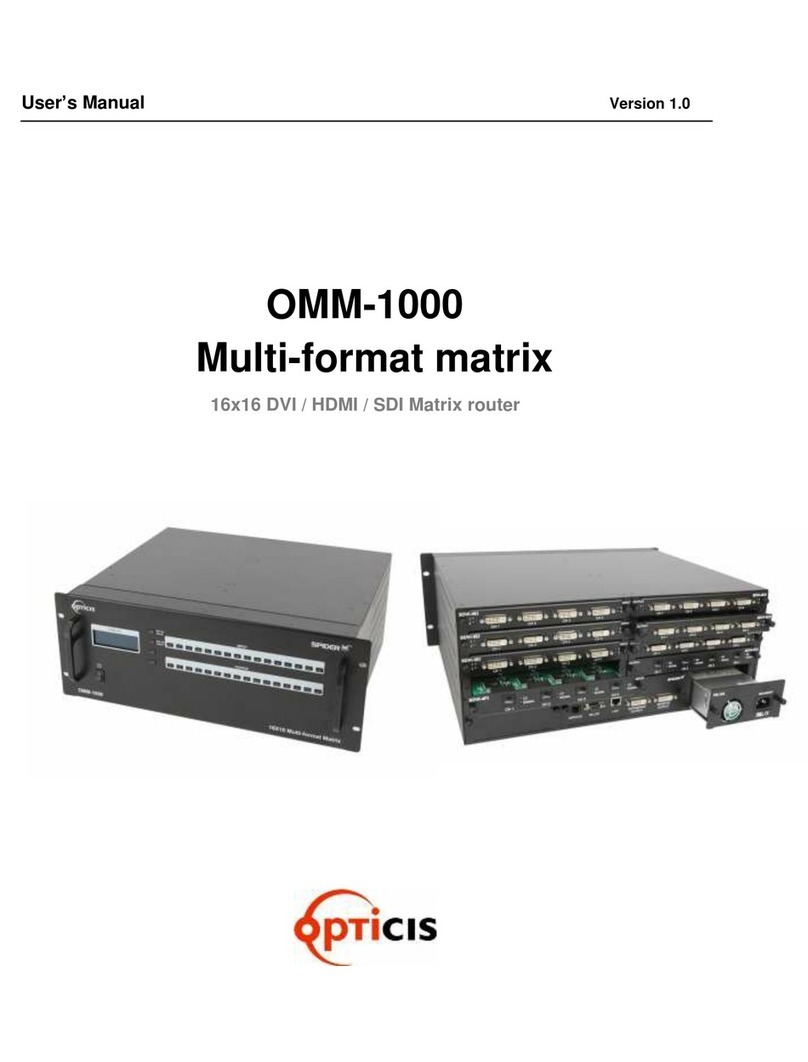
USER MANUAL
DVI MATRIX ROUTER –ODM1818
ODM1818 Manual - Edition 7a Page 2
Table of Contents
1Introduction and Installation...................................................................................................................4
1.1 Key features:.................................................................................................................................4
1.2 ODM1818 Shipping Content:........................................................................................................4
1.3 Safety Instructions.........................................................................................................................5
1.4 Physical Description......................................................................................................................5
1.4.1 Front Panel................................................................................................................................5
1.4.2 Rear Panel ................................................................................................................................6
1.5 EDID Control and Configuration....................................................................................................7
1.6 Connecting Optical DVI cables and modules for extended distance............................................8
1.7 Initializing ODM1818 and Installation Guide.................................................................................8
1.7.1 Initialization................................................................................................................................8
1.7.2 Rack Mounting ..........................................................................................................................9
1.7.3 Control Connection....................................................................................................................9
1.7.4 RS-232 Control..........................................................................................................................9
1.7.5 Ethernet Control........................................................................................................................9
2Communications Setup..........................................................................................................................9
2.1 Setting the Router ID of ODM1818...............................................................................................9
2.2 Front Panel Interface...................................................................................................................10
2.3 CREATE Mode............................................................................................................................10
2.4 PREVIEW Mode..........................................................................................................................10
2.5 CANCEL Mode............................................................................................................................11
2.6 FUNCTION Mode........................................................................................................................11
2.6.1 MONITOR OUTPUT SELCTION. ...........................................................................................11
2.6.2 RS-232 BAUD RATE ..............................................................................................................11
2.6.3 GATEWAY ..............................................................................................................................12
2.6.4 SUBNET MASK.......................................................................................................................12
2.6.5 IP ADDRESS...........................................................................................................................12
2.6.6 MAC ADDRESS......................................................................................................................13
2.6.7 PORT NUMBER......................................................................................................................13
2.6.8 EDID SAVE.............................................................................................................................14
2.6.9 COMMNAD TYPE...................................................................................................................14
2.6.10 FACTORY MODE ...............................................................................................................14
2.7 Serial Communication.................................................................................................................14
2.7.1 HyperTerminal.........................................................................................................................14
2.7.2 Telnet ......................................................................................................................................16
2.7.3 LAUNCHING TELNET SESSION...........................................................................................16
2.8 Ethernet Control..........................................................................................................................18
2.8.1 SETTING THE IP ADDRESS of the PC..................................................................................18
2.9 USB CONTROL ..........................................................................................................................19
3Operation .............................................................................................................................................19
3.1 Front Panel Operation.................................................................................................................19
3.2 Command Line Operation...........................................................................................................21
3.2.1 Create......................................................................................................................................23
3.2.2 Preview....................................................................................................................................24
3.2.3 Cancel. ....................................................................................................................................24
3.2.4 Upload Data Request..............................................................................................................24
3.2.5 Upload Data Request:.............................................................................................................25
3.2.6 Rolling command.....................................................................................................................25
3.2.7 Upload Router ID.....................................................................................................................26






























